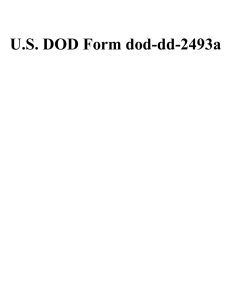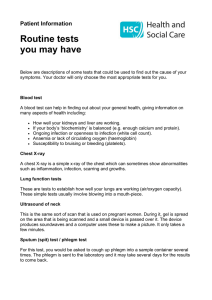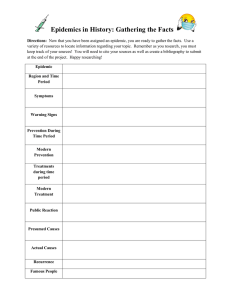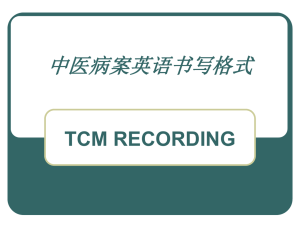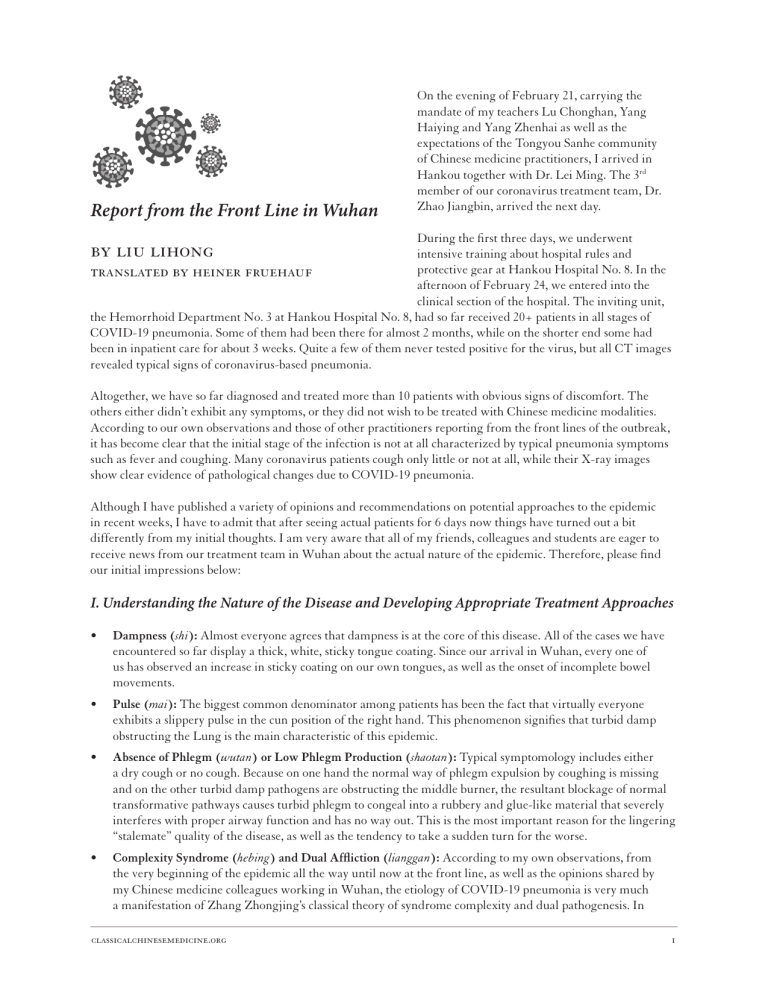
Report from the Front Line in Wuhan On the evening of February 21, carrying the mandate of my teachers Lu Chonghan, Yang Haiying and Yang Zhenhai as well as the expectations of the Tongyou Sanhe community of Chinese medicine practitioners, I arrived in Hankou together with Dr. Lei Ming. The 3rd member of our coronavirus treatment team, Dr. Zhao Jiangbin, arrived the next day. During the first three days, we underwent intensive training about hospital rules and protective gear at Hankou Hospital No. 8. In the translated by heiner fruehauf afternoon of February 24, we entered into the clinical section of the hospital. The inviting unit, the Hemorrhoid Department No. 3 at Hankou Hospital No. 8, had so far received 20+ patients in all stages of COVID-19 pneumonia. Some of them had been there for almost 2 months, while on the shorter end some had been in inpatient care for about 3 weeks. Quite a few of them never tested positive for the virus, but all CT images revealed typical signs of coronavirus-based pneumonia. by liu lihong Altogether, we have so far diagnosed and treated more than 10 patients with obvious signs of discomfort. The others either didn’t exhibit any symptoms, or they did not wish to be treated with Chinese medicine modalities. According to our own observations and those of other practitioners reporting from the front lines of the outbreak, it has become clear that the initial stage of the infection is not at all characterized by typical pneumonia symptoms such as fever and coughing. Many coronavirus patients cough only little or not at all, while their X-ray images show clear evidence of pathological changes due to COVID-19 pneumonia. Although I have published a variety of opinions and recommendations on potential approaches to the epidemic in recent weeks, I have to admit that after seeing actual patients for 6 days now things have turned out a bit differently from my initial thoughts. I am very aware that all of my friends, colleagues and students are eager to receive news from our treatment team in Wuhan about the actual nature of the epidemic. Therefore, please find our initial impressions below: I. Understanding the Nature of the Disease and Developing Appropriate Treatment Approaches • Dampness (shi): Almost everyone agrees that dampness is at the core of this disease. All of the cases we have encountered so far display a thick, white, sticky tongue coating. Since our arrival in Wuhan, every one of us has observed an increase in sticky coating on our own tongues, as well as the onset of incomplete bowel movements. • Pulse (mai): The biggest common denominator among patients has been the fact that virtually everyone exhibits a slippery pulse in the cun position of the right hand. This phenomenon signifies that turbid damp obstructing the Lung is the main characteristic of this epidemic. • Absence of Phlegm (wutan) or Low Phlegm Production (shaotan): Typical symptomology includes either a dry cough or no cough. Because on one hand the normal way of phlegm expulsion by coughing is missing and on the other turbid damp pathogens are obstructing the middle burner, the resultant blockage of normal transformative pathways causes turbid phlegm to congeal into a rubbery and glue-like material that severely interferes with proper airway function and has no way out. This is the most important reason for the lingering “stalemate” quality of the disease, as well as the tendency to take a sudden turn for the worse. • Complexity Syndrome (hebing) and Dual Affliction (lianggan): According to my own observations, from the very beginning of the epidemic all the way until now at the front line, as well as the opinions shared by my Chinese medicine colleagues working in Wuhan, the etiology of COVID-19 pneumonia is very much a manifestation of Zhang Zhongjing’s classical theory of syndrome complexity and dual pathogenesis. In classicalchinesemedicine.org 1 report from the front line in wuhan | liu lihong other words, one can confidently say that this particular epidemic from beginning to end bears the characteristics of what is called Complexity Syndrome and Dual Affliction in the Shanghan zabing lun (Treatise on Disorders Caused by Cold and Miscellaneous Disorders). None of the cases we encountered manifested with simple Taiyang Syndrome in the initial stages of the disease, but they all came down right away with Taiyang Yangming Combination Syndrome, or even a situation where all three yang channel systems (taiyang, drs. ming, liu, and jiangbin yangming, shaoyang) were involved. Many patients exhibit signs of dual pathogenesis right from the get-go, by coming down with a rapidly progressing respiratory infection with signs of both taiyang and shaoyang disease. In some instances, the disease lingers at the yangming taiyin dual affliction stage, while others suffer from taiyang shaoyang dual affliction that is further complicated by yangming taiyin issues. Comparatively speaking, shaoyang jueyin dual afflictions are rare. As for the Complexity Syndrome (hebing) variant, which specifically refers to a situation where both the surface and the interior and zang and fu organ systems are involved at the same time, an example would be the simultaneous affliction of the Lung and the Large Intestine. An appropriate prescription needs to take all of these aspects into consideration. Many of the recently publicized anti-COVID-19 formulas display this characteristic of complexity. The Cinnamon Method (Guizhi Fa) approach suggested by my Fire Spirit School mentor Dr. Lu Chonghan, furthermore, represents a typical approach to Taiyang Yangming Complexity Syndrome. Other suggestions, such as Ma Xing Shi Gan Tang (Ephedra, Apricot Seed, Gypsum, and Licorice Decoction) and similar remedies, or Mahuang Tang (Ephedra Decoction) plus Weijing Tang (Phragmites Decoction) are all examples for approaches to more complex syndromes. For dual affliction (lianggan) conditions, moreover, the Aconite Method (Sini Fa) of the Fire Spirit School is also an important method to consider. Especially in situations where “dampness is pronounced and yang is feeble” (shisheng yangwei) the inclusion of aconite containing formulas is particularly appropriate. Aconite, of course, should always be used cautiously—proper differential diagnostics is always the most important prerequisite for any prescription! • Moisten Dryness and Transform Phlegm, Remove Zang Disease via the Corresponding Fu Organ How is it possible to liberate the airways by expelling the sticky, rubbery, glue-like phlegm that is obstructing the lungs all the way into the alveoli? This question is most relevant for the eventual outcome of the disease process! Why is the typical COVID-19 patient hardly coughing or not coughing at all? I believe that this specific characteristic of the disease is mostly due to the presence of sticky phlegm, which occupies the available airway space normally required for the generation of a productive cough. From the perspective of Chinese medicine, this phenomenon belongs to the category of dry phlegm (zaotan). This kind of issue requires an approach that involves moisturizing dryness and transforming phlegm (runzao huatan). The herb Dongguaren (Benincasa), for instance, from the afore-mentioned remedy Weijing Tang is a representative herb in this category. Many other seeds possess this type of therapeutic function, i.e. Gualouren (Trichosanthes seed), Laifuzi (Radish seed), Baijiezi (Mustard seed), etc. However, this type of super-sticky phlegm cannot necessarily be completely expelled via the prescription of moisturizing and phlegm transforming herbs. This is where the maneuver of utilizing the zang-fu relationship of Lung and Large Intestine comes into play, by removing zang disease by way of the associated fu organ; by addressing yin disease via its yang counterpart. This approach has often been used within the versatile arsenal of Chinese medicine modalities. Examples can be found in historical case studies. Specifically, this means that the seed varietals of phlegm transforming herbs, if used in sufficient amounts, can expel residual glue-phlegm from the Lung via the Large Intestine. In the arena of acupuncture, the corresponding method would be to needle Taiyuan (LU9) all the way connecting to Yangxi (LI5), or Yangxi all the coronavirus team at hankou hospital no. 8 way to Taiyuan. classicalchinesemedicine.org 2 report from the front line in wuhan | liu lihong II. The Importance of Acupuncture Therapy Our team began treating every single patient with acupuncture starting on our first day in the coronavirus section. Because of the logistics associated with buying and preparing herbs, our patients started imbibing herbal decoctions only 3 days later. I remember how I felt slightly awkward when approaching my first patient with a needle. For one, the protective gear with its plastic eye goggles blurs the vision. Secondly, three layers of gloves greatly dull sensitivity in the needling hand. And thirdly, I was worried that the patient would trust me, a doctor who had never treated this kind of disease before. I was therefore completely taken by surprise when the patient exclaimed: “This works like a miracle! The stuffy feeling in my chest is completely gone!” And another patient said shortly thereafter: “My throat and chest area used to feel as blocked as a road during rush hour—now it has become like an open road without a single soul on it.” This sort of feedback was a pleasant and unexpected surprise for us, providing us with hope and strength at the same time. Most of the accompanying symptoms, such as stuffiness in the chest, shortness of breath, abdominal discomfort, itchy throat with the urge to cough, dizziness, cold sensation in the upper back, connective tissue pain, sweating, etc, did either decrease with the acupuncture treatments or resolve entirely. This experience proved that my earlier suggestion to “use acupuncture and herbal medicine together” in the treatment of this epidemic was realistic. Perhaps the greatest benefit of acupuncture is the immediate improvement in the emotional outlook of patients, since they get to experience a noticeable improvement in a short period of time. This aspect cannot be underestimated in the process of curing this disease. Overall, however, the term “cure” needs to be used with extreme caution in the context of this pneumonia epidemic. This is definitely not the kind of situation where one is all better once the fever has broken, or one is OK once the coughing spells come to an end, or when the virus test turns from positive to negative. There are at least 3 additional elements that are prerequisites for a complete cure of COVID-19 related issues: 1) The complete remission of pneumonia signs on CT images; 2) The normalization of all Lung channel abnormalities; 3) The disappearance of sticky tongue coating. Otherwise, the disease may come roaring back for another round! classicalchinesemedicine.org 3

